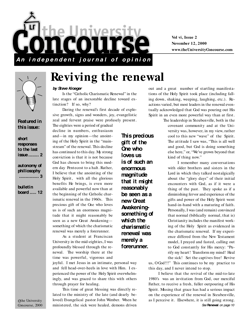Eastern Christianity and Western Liturgical Reform
by Adam Tate
The readers of the Concourse must thank Mr. Dragani for his Eastern Catholic perspective on Church matters. He has identified an important facet of Catholicism for all Western Christians to ponder: the rich, ancient tradition of the Eastern Fathers. His article, however, misses the heart of the debate in the Roman Catholic Church over the liturgy, and misleadingly suggests that one should understand the recent revision of the Roman Rite in terms of Eastern liturgical forms.
There is no doubt, as Mr. Dragani affirms, that part of the liturgical movement appreciated the Eastern liturgies and looked to them as models. The rich symbolism of the Eastern Rites, especially the Divine Liturgy of St. John Chrysostom (attended by Byzantine Catholics such as Mr. Dragani), and the participation of the congregation in Eastern liturgies gave hope to many reformers that the Roman Rite could be renewed or even improved. While many of the reforms that ended in the novus ordo missae of Paul VI appear Eastern in their inspiration, the transcendent, mystical spirit of the Eastern liturgies is well hidden in the novus ordo. Two examples should suffice.
Mr. Dragani mentions the free-standing altar as a reform inspired by the Eastern tradition. But the present use of the free-standing altar in the Roman Rite is hardly Eastern in its spirit. In the Liturgy of St. John Chrysostom, the priest does not face the people during the Eucharistic prayer and is even obscured from the view of the congregation during this time by the iconostasis (the wall of icons). The Eastern tradition emphasizes the separation of the priest from the people in the moment when heaven meets earth during the Epiclesis. The sense of mystery, awe, and transcendence is profound. Such is hardly the situation in the novus ordo. In the Novus Ordo the priest faces the people, breaking the ancient Christian liturgical tradition of facing east in worship, and seems more of an uninspired entertainer than one privileged to celebrate the Sacred Mysteries. It is not only traditionalists who have pointed out such things. People as diverse as Cardinal Ratzinger in his new book, The Spirit of the Liturgy, and Thomas Day in, Why Catholics Can’t Sing, have made similar critiques of the novus ordo.
Mr. Dragani also suggests that the Eastern practice of receiving communion under both kinds while standing was adopted by the reform of Paul VI. Again, this is misleading. The Eastern Catholics who attend the Liturgy of St. John Chrysostom receive Holy Communion on the tongue, not in the hand, with their hands crossing their breast as a sign of reverence. They receive by intinction from an ordained minister. The ordained thus fulfill their primary duty of feeding the people the Holy Eucharist. In the present Roman Rite, most Catholics receive the Eucharist in the hand. Then they turn and drink the Precious Blood from a cup. In most parishes, extraordinary ministers of the Eucharist (who, sadly, are in fact quite ordinary) give communion, and the people make no signs of reverence during or before receiving Christ’s body and blood. If the Eastern practice was the model for reform, then something has gone terribly wrong.
The debate over liturgy among Roman Catholics today is primarily about the preservation of the ancient liturgical traditions of the Roman Rite. The mass promulgated by Pope St. Gregory the Great was virtually the same in all its essentials as the mass celebrated until Vatican II. The Eastern Christians, who have so zealously guarded their own liturgical traditions from tampering, should realize that Roman Catholic traditionalists like myself do not ignore the Eastern Rites, but admire them for their adherence to their venerable liturgical traditions. Roman Catholic traditionalists are fighting to restore the traditions of our own Rite. We are not immobilists who want to freeze liturgical development at the Council of Trent, but instead desire a true, organic development of our Rite rather than its whole scale dismantling, which we witnessed after Vatican II. Some may call us close-minded or many other worse things, but we traditionalists desire to worship as our Eastern Catholic brethren do, according to our own traditions. Traditionalists believe that we are being prevented from doing so by intransigent bishops, and those who mistakenly see our criticism of the novus ordo as disloyal to the Church.
Adam L. Tate, FUS Class of ‘94


